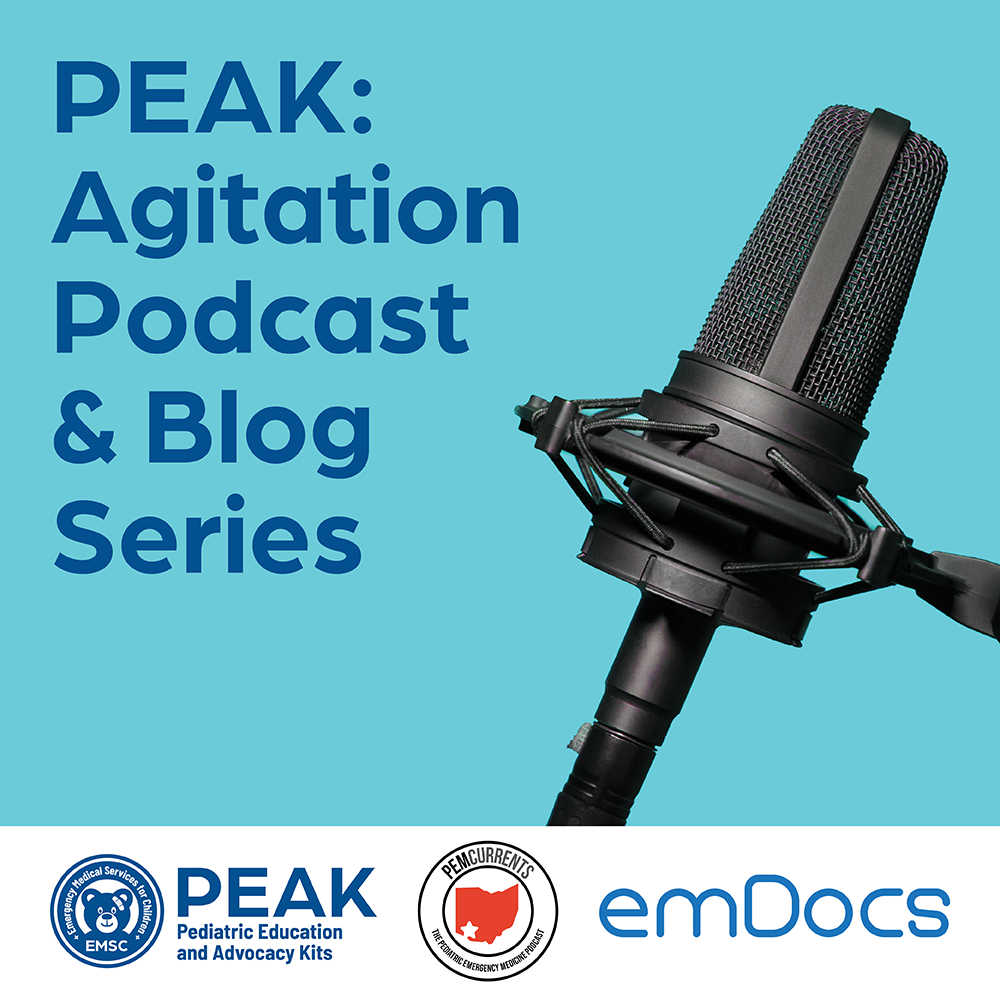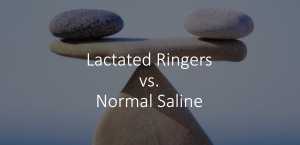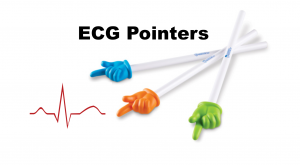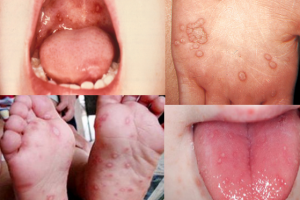Original podcast posted on PEM Currents – Hosted by Brad Sobolewski (@PEMTweets) and co-authored by Dennis Ren (@DennisRenMD)
This podcast series by PEM Currents is a co-production with the Emergency Medical Services for Children Innovation and Improvement Center (EMSC IIC), whose mission is to minimize morbidity and mortality of acutely ill and injured children across the emergency continuum.
The emDOCs.net team is very happy to collaborate with PEM Currents and EMSC IIC to further disseminate this 5-part podcast series focusing on agitation in children and adolescents.
Podcast: Play in new window | Download (Duration: 15:51 — 21.8MB)
Subscribe: Apple Podcasts | Google Podcasts | RSS
Safe prehospital transport of the agitated child
In episode 1 of this series, we discussed differentiating organic vs psychiatric causes of agitation in children. Episode 2 covered non-pharmacologic management and episode 3 covered pharmacologic management of agitation. In today’s episode, we’re taking our show on the road. How do we manage the agitated child in the pre-hospital environment?
There are protocols in place that assist highly trained Emergency Medical Service providers in assuring that agitated children are safely transported to their destination.
After listening to this episode you will be able to:
- Identify unique aspects of the pre-hospital environment that impact assessment and treatment of agitated children
- Describe the role of EMS personnel and EMS director in the care of agitated children.
- Describe the role of medical control in determining destination and goals of safe transport
Goal
Let’s keep in mind that the overall goal is safety and prevention of injury for everyone. That includes the patient, EMS personnel, and general public.
Protocols
Every EMS agency should have protocols for dealing with agitated or violent patients. We’re defining “protocol” here as a written document that provides oversight from the medical director about how to assess and treat patients. Sometimes these can also be referred to as guidelines, standing orders, policies, or procedures. These protocols are often developed in collaboration with multiple stakeholders that can include EMS staff and administration, legal counsel, community members, law enforcement.
These protocols should be patient-centered and approved by EMS medical director and should address:
- Restraint strategies, devices, techniques
- When each should be used
- Who can apply them
- Whether or not medical oversight is required.
These protocols should also specify what techniques are NOT allowed.
Education & Credentialing
It is up to the EMS agency to provide education about recognizing, assessing, and treating agitated patients and training on implementing restraints or administering medications
The EMS medical director is ultimately responsible for credentialing the practitioners and determining competency.
Assessment of Underlying Medical Condition
Let’s start at the scene. EMS must rapidly assess the patient and attempt to determine if there is an underlying medical condition contributing to the patient’s agitation and address if there is one:
- Hypoxia, electrolyte derangement, intoxication, head/brain injury, seizure
-
- Apply oxygen if concern for hypoxia
Some EMS agencies may use an agitation score like the Richmond Agitation Sedation Scale (RASS)
Patient Dignity
EMS should maintain the patient’s dignity as much as possible. This means using the least restrictive method of restraint possible that will protect the patient, EMS personnel, and the public. As usual, de-escalate whenever possible before resorting to physical or chemical restraints.
EMS Environment
Ok, we’ve got the patient calmed down and gotten them into the ambulance. Now as we transition to this new environment, let’s talk about some special considerations. Unlike a hospital, there is limited space, staff, equipment, and medication. Because of these factors, the restraint techniques and thresholds to restrain a patient differ from the in-hospital environment.
- If you have restraints in your ambulance, are those restraints appropriately sized for pediatric patients?
- position the patient carefully so not to obstruct airway
Indications for Restraint
There are specific indications for EMS to apply physical restraints or administer chemical restraints.
There are 3 main indications:
- Protect patient, public, EMS from injury
- Facilitate assessment
- Allow treatment of life-threatening condition
EMS often works closely with law enforcement but should NOT administer medications for the sole purpose of aiding law enforcement in arrest.
Strategy and Techniques
Moving on to some specific strategies and techniques:
Physical Restraint
Look to your EMS agency’s protocol that should provide instruction of what type of physical restraints and techniques are appropriate. Use the least restrictive method of restraint to preserve the dignity of the patient. Must be able to be rapidly removed if there is clinical concern for a patient. EMS does not use restraints like handcuffs or flex cuffs that are typically used by law enforcement.
- If patient is restrained by law enforcement device, try to transition to EMS-sanctioned device
If a patient is restrained by a device that requires a key, the key must accompany the patient during transport.
Prohibited Techniques
Patients should never be restrained with their hands and feet tied together behind their back. Always be careful with any technique or position that may compromise the airway.
- Spit hoods or face shields may obstruct the airway
Patients should also never be restrained in a in prone position or under any backboards/mattresses/
Pharmacologic Management
We covered many of the common medications that are in our toolbox in episode 3 of this series. However, in the pre-hospital environment, these medications are often much more limited. Look at your EMS agency’s protocol as preferred medications may vary based on jurisdiction.
Common medications include:
- benzodiazepine
- Lorazepam – 0.05-0.1 mg/kg/dose (PO/IM/IV)
- Midazolam – 0.25-0.5 mg/kg/dose PO; 0.2-0.3 mg/kg IN; 0.1-0.15 mg/kg/dose IM
- Ketamine
- Droperidol
- Any combination of these
For the acutely agitated patient, we want something that is more rapid onset which means that it is much more likely these medications will be given IM or IN. PO onset usually takes much longer. Using a paralytic or neuromuscular agent is not acceptable by itself. Let’s be real. Giving a paralytic without sedation is straight up torture. EMS personnel should be aware of side effects of these medications. Overmedicating a patient may lead to over sedation. It is always OK to contact medical control for advice.
Reassessment and Documentation
After any type of restraint is instituted, careful assessment, re-assessment, and documentation is required.
- Includes respiratory status, hemodynamic status, neurovascular status
- Document the patient behavior, indication for restraint, type of restraint, exam findings, agitation scores if used
Direct Medical Oversight
Remember, you are not all alone in the pre-hospital environment! There is the option for online medical control or direct medical oversight. In some EMS systems, EMS personnel must consult when dealing with agitated patients who refuse treatment or for orders to initiative any type of physical restraint or administering any pharmacologic restraints.
The protocol we talked about earlier that is developed by the EMS medical director should be clear about when and in what situations EMS personnel are required to contact a physician. Any physician providing direct medical oversight as a base station should also be familiar with these protocols.
If pharmacologic or physical restraints are used, it is very helpful to notify the receiving emergency department prior to arrival so they can be prepared.
It is helpful to include information about:
- What was the emergency and what was the need for treatment
- That the patient refused treatment or could not consent to treatment (specify why, were they unconscious, deemed incompetent or unable to refuse treatment)
- What less restrictive methods were trialed prior to administering physical or pharmacologic restraints
- What treatments and/or restraints were used
- If there were any injuries sustained
- Changes in behavior or mental status after restraints were employed.
- Whether or not law enforcement officials are involved
INCLUDE ADVICE ON WHAT TO TELL THE PHYSICIAN AT THE RECEIVING HOSPITAL
Quality Assurance
Cases where physical or chemical restraints are used should be reviewed routinely:
- Was the use of restraint appropriate?
- What type of restraint was used?
- Was the monitoring appropriate?
- Was the protocol followed?
- Was the documentation complete?
Safety and Law Enforcement
Remember, if you feel like you cannot make it to your destination safely, pull over and call for help. A truly agitated patient may be better served being stabilized at the nearest hospital rather than longer transport to an academic children’s hospital. Law enforcement officers, if available, should be involved in situations when the patient is at risk of injuring themselves, EMS, or the public.
Remember that EMS and law enforcement techniques for restraint are different. Any patient who is restrained by law enforcement may develop a need for EMS assessment and care. The law enforcement officer is expected to be readily available. Patients who are in custody or arrested should be accompanied by a law enforcement officer during transport.
Resources
- emDOCs.net Articles
- PEM Blog via Brad Sobolewski (@PEMTweets)
- EMSC IIC (Emergency Medical Services for Children Innovation and Improvement Center)
- EMSC IIC: Pediatric Education and Advocacy Kit (PEAK): Agitation
- EIIC/TREKK: Care of the Agitated Patient Algorithm
- EIIC/TREKK: Agitation Medication Dosing Recommendation Table
- EIIC: De-escalation Tips for Pediatric Agitation Infographic
- EIIC: Emergency Department Management of the Agitated Pediatric Patient Interactive Learning Module
- EIIC: Agitation in Neurodivergent Patients with Drs. Alice Kuo and Ilene Claudius Podcast
- EIIC: Safe Control of the Agitated Patient Webinar Series with Dr. Marianne Gausche-Hill
- New England EMSC: New England Regional Behavioral Health Toolkit
- For more info, please email km@emscimprovement.center or follow on Twitter @EMSCImprovement
- EMSC IIC: Pediatric Education and Advocacy Kit (PEAK): Agitation
Other Episodes in the Agitation Series
Episode 1: Differentiating organic versus psychiatric causes of agitation and altered mental status
Episode 2: Non-pharmacologic management of agitated children
Episode 3: Pharmacologic management of agitated children
Episode 4: Safe pre-hospital transport of the agitated child (Current)
Episode 5: Management of the child with mental health problems who is boarded in the Emergency Department (Coming June 14, 2023)
References
Kupas D et al. NASEMSO: Clinical care and restraint of agitated or combative patients by emergency medical service practitioners. https://nasemso.org/wp-content/uploads/Clinical-Care-and-Restraint-of-Agitated-or-Combative-Patients-by-Emergency-Medical-Services-Practitioners.pdf
Patient restraint in emergency medical services [Position Statement]. Prehosp Emerg Care. 2017;21(3):395-396.









2 thoughts on “PEM Currents – Agitation in Children – Episode 4: Safe prehospital transport”
Pingback: Agitation Episode 3: Pharmacologic management – PEM Currents: The Pediatric Emergency Medicine Podcast
Pingback: Agitation Episode 2: Non-pharmacologic management – PEM Currents: The Pediatric Emergency Medicine Podcast